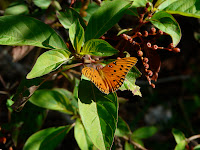The plant of the day was Bidens mitis, which lit up the landscape with beautiful golden-yellow fall color! Okefenokee Gold by Pete Johnson, Ixia Chapter On Saturday November 6, 2010, the Ixia Chapter and Sea Oats Chapter took a joint field trip to the Okefenokee National Wildlife Refuge (ONWR), East Entrance. The trip was well organized by Ixia president Barbara Jackson, who coordinated with Okefenokee Adventures to guide us on a boat tour. The turnout was big enough to fill four boats with eight people in each boat. The boats can hold more than eight, but the water level was very low due to lack of recent rainfall. The owners of Okefenokee Adventures, Chip and Joy Campbell, and their staff are courteous and very knowledgeable naturalists. They also run a great gift shop and lunch counter at the boat basin inside the ONWR. Chip guided the boat that I rode in and explained the Okefenokee is not just a swamp, but a peat bog system of wet prairies, marshes, cypress and hardw...









